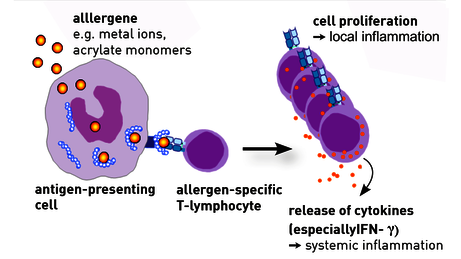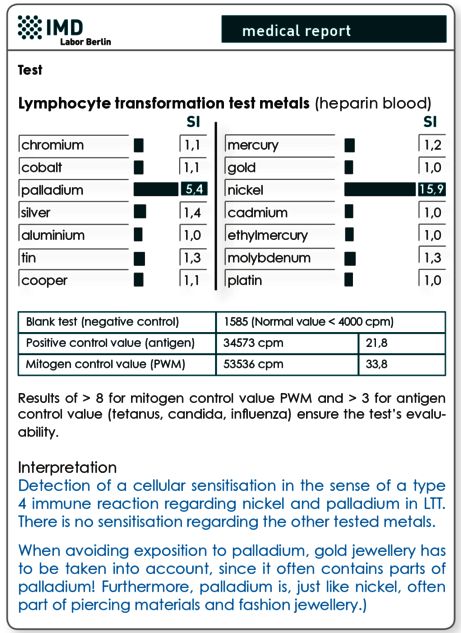Proof of sensitisations against dental restoration material
Dental restoration materials can cause allergies
Metals, acrylates (plastics), but also various other materials in root canal fillings or cements can potentially be allergens. Usually, sensitisations against dental materials are type 4 sensitisations (delayed-type allergies). Plastics and ingredients of root canal fillings, such as gutta-percha, eugenol, peru balsam, or colophony may also cause type 1 immediate allergies.
Type 4 allergies
Metals and plastics from dental restoration material are potentially allergens, because free metal ions or plastic monomers bind to endogen proteins, modify them and make them appear “unfamiliar” to the immune system (hapten effect). In case of an existing type 4 sensitisation, allergen-specific T-lymphocytes detect the unfamiliar allergen protein complex and react by activating the immune system (see fig. 1).

Fig. 1 metals, acrylate monomers and many other material compartments used in dentistry are haptens. They unfold their allergenic potency only after binding and modifying endogenous proteins.
Which symptoms may occur?
Local symptoms may include stomatitis, lichenoid inflammations, gingivitis, and periodontitis. However, they are not obligatory, since the oral cavity is not very reactive. Due to the systemic effect of IFN-γ, unspecific systemic symptoms of inflammation, such as exhaustion, muscular pains, arthralgias (fibromyalgia), paresthesia, headaches, or neuralgia, may occur as well. Local symptoms, such as burning sensation of the tongue, jaw aches or toothaches may occur even without morphologically visible correlates.
Furthermore, it has been proven that continuous exposure with metal ions (i.a mercury, gold, nickel) can trigger autoimmunity in patients with existing sensitisations.
The LTT can detect allergen-specific T-lymphocytes
The lymphocyte transformation test (LTT) is suitable for the detection of systemic cellular sensitisations. The epicutaneous test on the contrary is unsuitable, if the allergen’s absorption does not happen via skin, but instead e.g. via gastrointestinal mucosa. For an LTT, lymphocytes from the patient’s blood are isolated and confronted with the respective allergen. If a patient is sensitised for a certain allergen, lymphocytes are proliferated in the respective test assay. A positive LTT test result proves the existence of allergenspecific lymphocytes (memory cells) in the patient’s blood.

Fig. 2 sample report LTT metals
Two questions can be answered using the LTT:
1. Is it necessary to replace already existing dental restoration material?
A connection to the used material can be proven, or ruled out respectively, if complications occur after the administration of dental restoration materials (curative question).
2. Which materials should or should not be used?
Existing sensitisations against ingredients can be detected prior to the administration of new dental restoration materials (preventive question).
Which materials can be tested in an LTT?
Based on the most frequent requests, the following profiles that entail recognised sensitising individual allergens have been developed and standardised.
| LTT metals | gold, nickel, palladium, chromium, cobalt, molybdenum, aluminium, platinum, cadmium, mercury, copper, silver, tin, ethylmercury |
|---|---|
| LTT plastics | Methyl methacrylate (MMA/PMMA), TEGDMA, BISGMA, BISDMA, HEMA, Diurethane dimethacrylate, Ethylenglycoldimethacrylate, 1,4-Butanediol dimethacrylate, N,NDimethyl-4-toluidin, Benzoyl peroxide, hydroquinone, camphor quinone, phthalates, formaldehyde |
| LTT professional combination (dental check-up) | gold, nickel, palladium, chromium, cobalt, platinum, mercury, copper, silver, tin, Methyl methacrylate (MMA/PMMA), HEMA, TEGDMA, BISGMA |
| LTT gold alloys | gold, silver, platinum, copper, pallidum, tin, gallium, indium, iridium, rhodium, tantalum, ruthenium |
| LTT amalgam | mercury, copper, silver, tin (amalgam), ethylmercury, phenylmercury, methylmercury |
| LTT root filling materials | raw gutta-percha, peru balsam, eugenol, polydimethylsiloxane, silicone oil, bismuth oxide, silver, turpentine oil, colophony, triethanolamine, peanut oil, paraformaldehyde, bisphenol A, epichlorohydrin |
| LTT ceramics + cements | vanadium, aluminium, titanium, cobalt, chromium, barium, silicon, cerium, boric, manganese, antimony, phosphate cement, glass ionomer cement |
Type 1 allergies against acrylates and other non-metallic materials
Contrasting to metals, where allergic intolerances stem from type 4 sensitisations only, non-metallic materials (especially acrylates) can trigger IgE-induced allergies as well.
Type 1 immediate allergies should be considered if symptoms occur after few hours (rarely even minutes) after the material’s administration. Local, but also systemic wheallike changes of mucosa are typical, even though oral mucosa rarely shows typical morphology
How is the test in the laboratory run?
The basophil degranulation test (BDT) is an in-vitro method for the detection of type 1 allergic sensitisations and pseudo-allergies. The test is also known under the names of leukotriene-release test, basophile activation test, or CAST test. During testing, the patient’s basophile granulocytes are in vitro confronted with the allergen in question and, in cases of an existing allergy, the initiated synthesis of leukotrienes is measured. All acrylates occurring in commonly used dental restoration materials, as well as many allergens from root filling materials are available for laboratory tests.
Are tests available for native and individual materials as well?
Yes, for both LTT and BDT cements, composites, prosthesis materials, bone replacement materials, root filling materials (even root pins), as well as intra-orally obtained material shavings work as native material. They have to be send in together with the blood sample. Many materials are on hand at the laboratory (see backside of dentistry request form). Materials should always be tested in the same condition they will possess when administered on the patient (such as hardened cement, polymerised plastics).
Material
LTT: per profile (e.g. LTT metals) 20 ml heparin blood and 5ml serum. Tests of native materials require 5 ml heparin blood and 5ml serum per material. 5ml serum are sufficient for a number of test profiles and materials.
BDT: 2 ml EDTA or heparin blood per allergen or material.
For both tests, sample dispatch is done by courier service.
Invoicing
The invoice is sent from the laboratory to the patient directly. Please obtain the costs for the analysis from the pdf-document.
